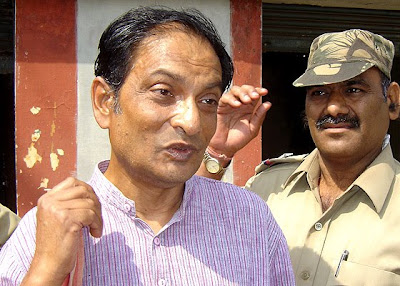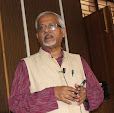
By Arindam Roy on February 17, 2011
Allahabad: For most of us, ‘Dalit’ means a nebulous homogenous mass of the downtrodden, disposed people, living in the margins of society. The harsh reality is otherwise. Dalits are a heterogeneous group. The differences between them are sharp and distinct. Dalits are arranged in hierarchy. Inequality, exclusion, contestations and other social tensions are not only present, it’s rampant. Beneath the calm surface of Dalit class consciousness is submerged violence. Deep within it is red hot – bubbling and boiling like the core of the earth.
These tensions burst forth, now and then. Those who enjoy power amongst the Dalits have created a ‘public sphere’ for themselves, while the ones that contest it have given rise to a ‘counter public sphere’. The tensions and frictions between these two might be seen, if you care to peel off the surface paint.
Uttar Pradesh ruled by a Dalit ki beti (daughter of Dalit), Mayawati, has become a laboratory of the tensions amongst Dalits. Two incidents on Sunday, Feb 13, 2011, are worth close examination:
First, when the chief minister, Mayawati, was in Allahabad, a Dalit rape victim, Munni (name changed) fell at her feet seeking justice. Munni had been raped twice. In 2004, Anil Singh with two others allegedly took her against her will. In 2010, she was reportedly raped by Nandlal, husband of a lady village pradhan. In the latter case, the rape victim named two Bahujan Samaj Party (BSP) leaders, Deep Chand Gautam, district BSP president, and Prem Chandra, stating that they were pressurizing her to withdraw her case against Nandlal. She had to face police apathy too.
Second, at Nawabganj, Bareilly, Munendra Gangwar, 30, the son of BSP MLC Kesar Singh Gangwar, allegedly shot at the Dalit farmer Kalicharan Jatav. The farmer had dared to refuse to sell 15 bighas of agricultural land at a throwaway price to the BSP tough. Jatav was dragged inside a SUV. When he tried to escape, he was shot at. Presuming him dead, the BSP leader’s son and henchmen left, throwing him out of the SUV. The Dalit farmer was gravely injured. “The MLC and his toughs were forcing me to sell the land. I also said my life was in danger. But the police didn’t help,” he said. The police have registered a case against Munendra and his two accomplices, but are allegedly trying to protect the BSP MLC.
Meanwhile, in December last year, a BSP MLA from Banda, Purushottam Naresh Dwivedi, allegedly raped a 17- year Dalit girl.
The latest report of the National Crime Record Bureau (NCRB) says that UP led the country in the number of crimes against Dalits in 2009. Of a total of 3,35,94 crimes against Dalits in 2009, 7522 took place in UP, followed by Rajasthan ( 4985), Andhra Pradesh ( 4504), Bihar ( 3836), Madhya Pradesh ( 3040) and Maharashtra (1096). UP also has the most reported instances of violation of the Scheduled Castes / Scheduled Tribes (Prevention of Atrocities) Act. Out of 11,143 cases in the country, 2554 cases (22.9 per cent) were reported from UP.
The chairman of National Commission for Scheduled Castes and Scheduled Tribes PL Punia, erstwhile principal secretary to Mayawati, described UP as the ‘worst offender’ for crimes against Dalits.
He accused Mayawati of shielding two ministers suspected to be involved in the murder of Rajender Singh, a junior engineer in the state Irrigation department. He was allegedly killed in August 2010, in Aligarh. “…the chief minister appears to have forgotten that she had come to power riding on the back of the Dalit community,” he agonized.
Punia added that on an average the Commission receives about fifty complaints by Dalits in UP in which the police have not even registered preliminary reports. He will soon make public, a list of officials from UP who had neglected, slackened on, or not taken cognizance of crimes committed against Dalits in the state. The Commission’s first step was to write to President Pratibha Patil and Prime Minister Manmohan Singh, drawing their attention to the rapidly rising graph of atrocities against Dalits, he said.
Social reality of Dalits
Numbering 160 million, Dalits represent 16 per cent of India’s population of more than one billion. Officially, caste discrimination is banned in India and special quotas exist for Dalits in Parliament, state legislatures, village councils, government jobs and educational institutions.
The word Dalit conjures up the image of a community that is discriminated against. Their only sin being that they are of low birth. The social discrimination against the Dalits is similar to racial and other discriminations practiced in other parts of the world.
There are several communities amongst the Dalits – it’s more like circles within circles. While few Dalit communities are relatively better off, most are not even in the margins of the margin. Those who are better off often practice ‘exclusion’ – the evil that they fought and snatched power from the upper castes. They are not prepared to share their piece of cake with the less fortunate.
Chamars (shoe-making, leather tanning and agricultural labour being their profession) form the major chunk. They are relatively better educated and the Dalit intelligentsia belongs to this community. The Chamars also claim that they have their own Veda, known as Chamrved. Pasi and Dhobi communities are the next two major groups amongst the Dalits in UP. The list of dispossessed Dalits is long, but some like Dusadh, Basor, Dhanuk, Kori, Dhrikar, Kharwar, Kanjar, Nat, Bhuiyar, Chera, Jatsar, Rangrej[1], etc are nowhere near the door of state-led democracy.
The BSP-led state has given a sense of identity and pride that has come about with political empowerment to select Dalit communities, economic empowerment is a far cry. It’s worth mentioning that in this social milieu Mayawati rules.
Ever since she has come to power on her own, from May 2007, she has faced flak, not only from the so-called upper caste parties like Congress and the BJP, but also from the Dalit communities.
Last year, in Allahabad, some Dalit leaders blamed Dalit leaders accused Mayawati of favouring only a particular backward community to which she belongs.
Udit Raj of the Justice Party went on record, stating, “We have gathered Dalits here and are creating awareness among them to fight for their rights. For example the issue of reservation in private sector, or the Dalits who are being exploited in Uttar Pradesh, or about the issue of jobs that are disappearing, or the issue of land acquisition, we are discussing all such issues here.”
Nihare Rakesh, a former state deputy, went on to add, “The benefit of reservation is being availed by Mayawati’s community. Those who do not belong to her community are exploited with cruelty. The crime is on full flow. In every 18th minute a boycotted Dalit woman is raped, they are being killed in the whole state. I demand that the central government should immediately take action against Mayawati’s rule.”
Mayawati, however, brushes these criticisms as ‘politically motivated’. She has time and again said that her political opponents are out to ‘malign and tarnish her image’. But, with a Dalit’s daughter in power comes great expectations. How she fulfills the aspirations of so many people, particularly the marginalized, needs to be seen. Let’s not to forget that UP is hardly a state. Its population is enough to make it the sixth largest country of the world, in its own rights.
A political observer (unwilling to be named), rightly pointed out that hidden behind the dazzle of gold, diamond and wealth, is a crown of thorns that Mayawati should adorn, everyday, with utmost humility and true prayers!
[1] Prasad, M. (2007). Uttaranchal Sahit Uttar Pradesh ki Dalit Jatiyon ka Dastavez, Delhi: Samyak Prakashan, pp 44-45
Link: http://editstreet.com/2011/02/dalits-against-dalits-is-mayawati-listening/













